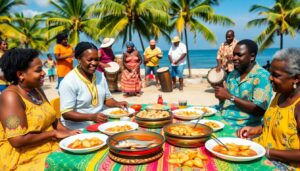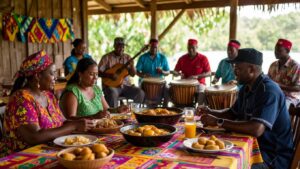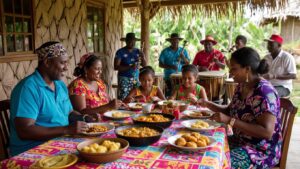Your cart is currently empty!
Garifuna Heritage and Cuisine: Discover Belize’s Culture

Unveiling the Rich Tapestry of Garifuna Culture in Belize: Heritage, Culinary Wonders & Memorable Experiences
The Garifuna community in Belize embodies a lively blend of African, Indigenous Caribbean, and European influences, crafting a distinctive cultural heritage that resonates globally and has earned recognition from UNESCO. Their extensive traditions span various domains, including language, music, culinary traditions, dance, spiritual practices, and a profound sense of community. This comprehensive guide explores the enchanting story of the Garifuna people in Belize, examining their historical background, cultural traditions, annual festivals, gastronomy, and the vibrant cultural scene of Hopkins Village.
Deep Dive into Garifuna Heritage and Identity
The Garifuna people are recognized as one of the most prominent ethnic groups in Belize, with their lineage tracing back to West and Central African ancestors, along with the Indigenous Caribs and Arawaks. After their courageous resistance against colonial domination in St. Vincent in 1797, they faced exile to Central America. Currently, approximately 30,000 Garifuna individuals reside in Belize, playing a pivotal role in enriching the cultural landscape of southern Belize through their unique language, delectable cuisine, vibrant visual arts, and rich customs. Their legacy has been honored by UNESCO as a Masterpiece of the Oral and Intangible Heritage of Humanity, showcasing their enduring creativity, resilience, and adaptability. Communities such as Dangriga, Hopkins, Seine Bight, and Punta Gorda, alongside diaspora populations across the Americas, continue to celebrate their heritage. The annual observance of Garifuna Settlement Day on November 19th serves as a powerful reminder of their resilience, community spirit, and vibrant cultural traditions.

Unearthing the Historical Journey of the Garifuna People
Tracing the Ancestral Roots of the Garifuna Community
The story of the Garifuna people begins in the 17th century with the extraordinary convergence of African survivors from two Spanish slave ships and the Indigenous Carib and Arawak populations of St. Vincent in the Lesser Antilles. Over the course of more than 150 years, intermarriage and cultural exchanges led to the emergence of a unique Afro-Indigenous identity known as the Garinagu. This identity is characterized by a rich tapestry of traditions, languages, and cultural practices that reflect their diverse ancestry and historical experiences.
Colonial Exile and the Birth of New Communities in Belize
In 1797, after fiercely resisting British colonial forces, around 5,000 Garifuna were forcibly exiled from St. Vincent to Roatán, Honduras. This marked the beginning of their migrations along the Central American coast. By the early 19th century, vibrant Garifuna communities had taken root in southern Belize, particularly in culturally significant areas like Dangriga, recognized as the cultural capital, as well as Hopkins, Seine Bight, and Barranco. The British government facilitated these migrations, seeking skilled laborers adept in fishing and agriculture, which aided in the establishment and growth of these communities.
Endurance and Cultural Preservation Amidst Challenges
Despite the numerous adversities brought on by European colonization, land dispossession, and systemic discrimination, the Garifuna have successfully maintained their language, social structures, and rich religious customs. The establishment of the National Garifuna Council in 1981 has been pivotal in advocating for cultural rights and education, ensuring that the Garifuna heritage continues to be honored and appreciated by future generations.
The Role of Language in Shaping Garifuna Cultural Identity
The Distinctive Features of the Garifuna Language
The Garifuna language, an Arawakan language, stands out due to its incorporation of Carib and African loanwords, making it a remarkable linguistic example among Central American languages. It is characterized by gendered pronouns, a complex tense system, and a treasure trove of oral traditions that encapsulate the community’s history and cultural values. Unfortunately, the survival of the Garifuna language is currently jeopardized by a language shift driven by urbanization and migration, with fewer than 15,000 Belizean Garifuna individuals remaining fully fluent.
Revitalization Efforts to Safeguard the Garifuna Language
The recognition of the Garifuna language and music as an Intangible Heritage by UNESCO in 2001 has sparked revitalization initiatives across the community. In areas like Hopkins and Dangriga, local primary schools have begun offering educational programs in the Garifuna language, while community radio stations broadcast music and news in Garifuna, contributing to its preservation. Organizations such as GAMAE International have launched language immersion summer camps aimed at reconnecting youth with their ancestral roots and cultural heritage.
Expressions of Identity and the Global Garifuna Diaspora
The Garifuna identity is enriched through traditional clothing, ancestral lineage, clan totems, and unique naming conventions. This identity is actively nurtured by cultural groups both within Belize and in diaspora communities in major cities like New York, Los Angeles, and London, where they continue to celebrate and preserve their cultural heritage.
The Dynamic Realm of Garifuna Music and Dance
The Spiritual Depth of Garifuna Rhythms and Drumming
Garifuna music is distinguished by its complex rhythmic patterns that seamlessly blend traditional African polyrhythms with indigenous chants and melodies. Central to many spiritual rituals and celebratory occasions, the drums—specifically the primero (tenor) and segunda (bass)—hold immense significance. The sacred dugú ceremony, for example, involves communal drum circles and ancestral invocations, aiming to heal or bless families, highlighting the profound connection between music and spirituality in Garifuna culture.
Celebrating Garifuna Dance: The Art of Punta and Punta Rock
Among the most revered Garifuna dance forms is the punta, celebrated for its rapid hip movements and intricate footwork, often paired with call-and-response singing and lively percussion. The contemporary evolution of this dance, known as punta rock, has gained popularity through renowned artists like Andy Palacio and Pen Cayetano, who merge traditional rhythms with modern instrumentation, thereby expanding the reach of Garifuna culture to audiences worldwide.
Community Celebrations and Cultural Festivals
In the vibrant towns of Hopkins and Dangriga, local dance troupes regularly perform during cultural festivals and for visiting tourists, fostering a living bridge between generations. These performances not only celebrate Garifuna heritage but also serve as vital economic resources for the community, promoting tourism and cultural exchange while keeping the traditions alive.

Diving into the Spiritual Practices and Cultural Beliefs of the Garifuna
Understanding the Importance of the Dugú Ceremony
The dugú ceremony is a multi-day event where extended families convene to honor the spirits of their ancestors, referred to as gubida. Under the guidance of a spiritual healer, or buyei, the ceremony includes music, dance, and communal feasting, all aimed at restoring harmony within families and the wider community. This ceremony underscores a profound respect for the land, ancestral heritage, and shared responsibilities.
Spiritual Beliefs that Shape Everyday Life of the Garifuna
The spiritual beliefs of the Garifuna reflect a unique synthesis of Catholicism intertwined with African and Arawak cosmologies. Daily life is infused with various rituals, including blessings for new buildings, rites of passage for births and deaths, and agricultural celebrations. Significant symbols, such as the conch shell, sea turtle, and cassava, serve as vital connections between households, the natural environment, and ancestral spirits.
Exploring the Gastronomic Heritage of Garifuna Cuisine
Signature Dishes and Culinary Staples of the Garifuna
The culinary heritage of the Garifuna culture is deeply rooted in essential staples such as cassava (or yuca), plantains, coconut, and fresh seafood. Among their traditional offerings, ereba stands out as a distinctive cassava bread crafted from grated cassava that is pressed and toasted over an open flame. Another notable dish, hudut, features fish simmered in rich coconut milk and served alongside mashed green and ripe plantains. Machuca, a hearty fish soup accompanied by garlicky, mashed plantain dumplings, and tapou, a savory seafood stew in coconut milk, are also favorites. In bustling street markets in Hopkins and Dangriga, visitors can delight in local specialties such as cassava pone (a sweet cake), fried plantain balls (known as ganún), and refreshing conch ceviche.
Promoting Sustainable Culinary Practices within the Community
Traditional Garifuna practices such as seasonal fishing, shellfish gathering, and small-scale gardening emphasize ecological stewardship. These practices are guided by cultural taboos and principles of communal resource management. Culinary festivals held in Hopkins feature cooking competitions and food tours organized by women’s cooperatives, ensuring the preservation of traditional recipes and cooking techniques while engaging visitors in the rich gastronomic heritage of the Garifuna.
Hopkins Village: The Heart of Garifuna Culture
Historical Significance and Cultural Relevance of Hopkins
Established in the early 1800s and known as Yarumein in Garifuna, Hopkins is located along the stunning Stann Creek coast. It serves as a crucial hub for the Garifuna language, music, and handicrafts, encapsulating the rich cultural legacy of the community.
Unmissable Experiences to Explore in Hopkins
- Drum Circles: Engage in daily drum schools and enjoy nightly drum circles hosted at local cultural centers.
- Garifuna Museum: Discover artifacts, oral histories, and photographic collections that delve into the migration, language, and music of the Garifuna.
- Homestays and Workshops: Interact with local families who offer cooking classes, fishing excursions, and demonstrations of cassava bread preparation.
Annual cultural events in Hopkins, especially the youth pageants during Garifuna Settlement Day, position the village as an authentic gateway for experiencing the rich cultural fabric of Garifuna Belize.
Economic Impact of Cultural Tourism on the Community
Cultural tourism is a vital component of Hopkins’ economy, supporting over 75% of local households through accommodations, handicrafts, music lessons, and guided tours. The headquarters of the National Garifuna Council coordinates regional festivals and advocacy efforts, ensuring that Garifuna culture remains vibrant and visible to the world.
Garifuna Settlement Day: A Cultural Celebration of Heritage
The Historical Context of Settlement Day Celebrations
Observed each November 19 since 1941 and nationally recognized since 1977, Garifuna Settlement Day commemorates the significant arrival of Garifuna ancestors in Belize by canoe in 1802. The reenactment procession known as Yurumein showcases villagers arriving ashore carrying drums, cassava, and crops amidst joyous singing and prayers, symbolizing their enduring legacy.
Contemporary Celebrations and Cultural Festivities
The festivities surrounding Garifuna Settlement Day beautifully intertwine sacred and secular elements, featuring all-night dugú ceremonies and continuous drumming in churches and community squares. Processions adorned in traditional attire, lively parades, dance performances, and food fairs mark the occasion. National broadcasts, media coverage, and diaspora celebrations in major US cities draw visitors from across Belize and beyond, fostering greater awareness and appreciation for Garifuna cultural traditions.
Addressing Modern Challenges and Ensuring Cultural Heritage Sustainability
The Language Shift Among Younger Generations
Language shift represents a significant threat to the Garifuna community, as many young individuals, particularly in urban environments, are increasingly adopting English or Kriol as their primary languages at home. Acknowledging this troubling trend, UNESCO has prompted schools and NGOs to implement language immersion programs, radio broadcasts, and mentorship initiatives designed to preserve linguistic heritage and cultural identity.
Land Rights and the Impacts of Tourism Development
The rapid growth of tourism and real estate development in coastal areas such as Seine Bight and Hopkins poses a threat to the traditional landholdings of the Garifuna. Advocacy efforts by the National Garifuna Council and collaborating NGOs aim to secure land rights, influence urban planning, and ensure that tourism revenues directly benefit local families and communities.
Engaging Youth through Arts, Technology, and Diaspora Connections
Garifuna artists and musicians, both within Belize and in the diaspora, are actively involved in recording music, documenting culinary recipes, and preserving oral histories to create digital archives and virtual festivals. These modern platforms are essential in fostering connections between the broader Garifuna community and younger generations, ensuring that their rich cultural heritage is maintained and celebrated for years to come.
Guidelines for Respectfully Experiencing Garifuna Culture
- Select accommodations in Hopkins, Dangriga, or Seine Bight, and book tours directly with Garifuna-owned businesses to support the local economy.
- Engage in a drum workshop, attend a Settlement Day celebration, or volunteer in local cultural preservation initiatives to immerse yourself in the culture.
- Support women’s cooperatives by sampling traditional dishes or purchasing handcrafted goods to promote sustainable livelihoods.
- Always respect local customs; seek permission before taking photographs of individuals, and be mindful during rituals and ceremonies.
- Learn a few basic phrases in the Garifuna language to demonstrate your respect and genuine interest in the culture.
Garifuna culture in Belize represents a vibrant tapestry woven with resilience, profound spirituality, infectious rhythms, exquisite culinary traditions, and strong community ties. By visiting places like Hopkins or Dangriga, participating in local festivals, or immersing oneself in the rhythmic heartbeat of the drums, travelers are offered a unique opportunity to engage with a rich historical continuum where the past and present beautifully converge. Supporting businesses run by the Garifuna, honoring their traditions, and celebrating the linguistic and culinary diversity of this remarkable culture are essential steps towards ensuring its survival and flourishing for generations to come.
References for Further Exploration
- Language, Dance and Music of the Garifuna – UNESCO Intangible Heritage
- History Of The Garifuna People – Belize.com
- Garifuna people – Wikipedia
- Varner, G.R. “Native Status and Maya Identity in Belize.” Journal of Latin American Anthropology, 1998
- Lee, N.R. “Toledo Garifuna and Indigenous Rights.” Mesoamerican Research, 2022
- National Garifuna Council – Wikipedia
- The Garifuna Living Heritage – ICH NGO Forum, 2023
- Dinther, R. “Language Shift and Prestige: Garifuna in Hopkins.” Journal of Pidgin and Creole Languages, 2017
- Habinaha Garifuna Language Program
- Veal, T. “Africanisms in Garifuna Culture of Belize.” Cultural Anthropology, 2004
- National Geographic: Preserving Garifuna Identity Through Ritual
- Music In Africa: Punta Rock and Garifuna Music
- Hopkins Cultural Center Official Site
- Cultural Survival Quarterly: Maya Rainforest and Garifuna in Belize
- Belize Living Heritage: Rituals and Social Practices
- Texas A&M: Belizean Food Culture
- Love Your Belize: Hudut Recipe
- Global M&A Pages: Sustainable Fishing Cooperatives
- National Garifuna Council of Belize
- UN Sustainable Development Reports on Garifuna Cultural Tourism
- Ambergris Caye: Garifuna Settlement Day Celebrations
- Garifuna.com: Diaspora, Digital Storytelling, and Modern Initiatives
The Article Garifuna Culture in Belize: Heritage, Food & Where to Experience It appeared first on Belize Travel Guide
The Article Garifuna Culture: Experience Heritage and Cuisine in Belize Was Found On https://limitsofstrategy.com

Leave a Reply